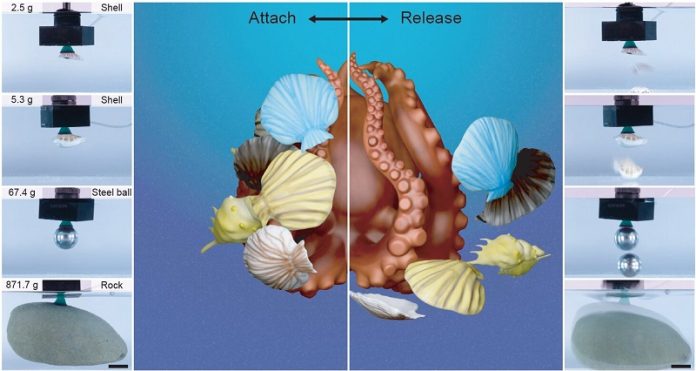
A team of researchers from Virginia Tech, led by Associate Professor Michael Bartlett, has developed a groundbreaking adhesive inspired by octopus suckers.
This new material could change the way we handle underwater objects, making it easier to grab and release items like rocks, shells, or even debris during salvage or rescue operations.
Their findings, recently published in Advanced Science, show that this octopus-inspired technology could be a game-changer for various underwater tasks.
Bartlett’s research team, which includes undergraduate students Austin Via, Aldo Heredia, and Daniel Adjei, as well as graduate researcher Chanhong Lee, was inspired by the incredible abilities of octopus suckers.
Octopuses can quickly grip onto objects of different shapes and textures and then release them just as fast, all while underwater.
This inspired the researchers to develop a similar adhesive that could be used by divers and other underwater workers.
Bartlett explained, “I’m amazed at how an octopus can hold onto something firmly and then release it instantly. It can do this with objects that are rough, curved, or irregular, which is quite remarkable.”
How the Adhesive Works
To recreate this unique ability, the researchers focused on the shape and structure of the octopus’s suckers, particularly the outer part called the infundibulum.
This structure allows the octopus to stick to different surfaces, no matter their size, shape, or texture.
The team designed an adhesive with a curved stalk and a deformable membrane, which can change shape to fit a variety of surfaces.
This flexible design helps the adhesive stick to both large, curved objects and smaller, rougher ones. The result is an adhesive that can grip tightly but also release quickly, switching between these states in just 30 milliseconds—faster than the blink of an eye.
This new adhesive is 1,000 times stronger when activated compared to its easy-release state. It works on various surfaces, including those that are rough, curved, or irregular, and in different fluids. With this technology, a diver could grab onto slippery objects without applying too much force and release them quickly when needed.
Testing the Adhesive
To test their new adhesive, the researchers simulated real underwater conditions. They created an underwater cairn, a carefully balanced pile of rocks.
The rocks varied in size, shape, and surface texture, but the adhesive was able to pick them up and place them precisely without disturbing the structure. The team also tested the adhesive on soft, jelly-like beads to show its versatility.
“These types of manipulations are similar to what an octopus does when arranging objects around its den,” said Chanhong Lee, the lead author of the study.
The adhesive also proved to be durable. In one experiment, the adhesive maintained a consistent grip over 100 cycles of use.
In another test, the adhesive held onto a rough, curved rock for more than seven days underwater before releasing it on command. This ability to grip objects securely for long periods is crucial for underwater salvage operations, where items may need to be held for extended periods.
Applications in Salvage, Rescue, and More
This adhesive could be incredibly useful in underwater salvage operations, where objects need to be lifted and moved carefully. It could also be valuable for rescue divers, underwater archaeologists, and other professionals working in challenging underwater environments.
Bartlett’s team had previously developed a product called “Octa-Glove,” a glove equipped with octopus-inspired adhesives and LIDAR sensors to detect and grab nearby objects without applying too much pressure. The glove could be used for various underwater tasks, from rescue missions to archaeological exploration. The new adhesive design could make the Octa-Glove even more powerful, with stronger gripping abilities and more precise control.
“We’re excited about how this new adhesive design can improve the Octa-Glove and other underwater tools,” Bartlett said. “The underwater environment presents many challenges, but this advance brings us closer to replicating the octopus’s incredible ability to grip and manipulate objects with precision.”
This new technology could open up countless possibilities for underwater exploration, salvage, and other tasks that require precise, reliable gripping in wet environments. The future of underwater work might soon rely on these octopus-inspired innovations.



